Church of St Peter
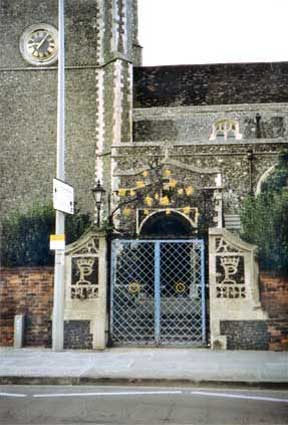 2011 image
2011 image
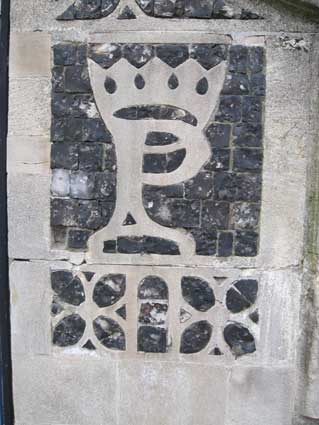 Flushwork
'P'
Flushwork
'P'
St Peter is one of twelve medieval
churches in Ipswich town centre, and was built in Romanesque style as
the church of
the Augustinian Black Canons of the Priory
of St Peter and St Paul. The
existing aisles were added in 1400 and the west tower in 1470. Cardinal
Thomas Wolsey confiscated and refurbished the church in 1528 to serve
as the chapel of
his short-lived Cardinal College of St Mary.
Ten years later, through the good offices of Thomas Cromwell, St
Peter became an ordinary parish church, returned to its congregation.
Strange to think that,
if Wolsey hadn't poured so much of his money into Oxford University and
if he hadn't fallen out with Henry VIII, this area could now be the
centre of a large public school designed to feed students to Oxford
University. The
'watergate' to what would have been the College - the Wolsey Gate in
College Street next to the church - features (partly) in our
photographs of the disappearing 'Burtons'
sign. As one of the most important historic buildings in Ipswich, it's
easy to miss the flushwork (knapped flint and stone) lettering flanking
the west door gateway (see note 1.
below) and
the crowned initial 'P' either side of the College Street entrance (see
note 2. below). A
lottery grant in 2006 enabled restoration of the run-down church as 'St
Peters's on the the Waterfront': a
home
for the Ipswich Hospital Band and an excellent performance venue.
Wolsey's Gate is only a few yards down
College Street from here.
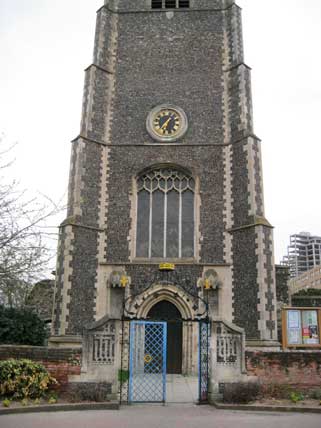 2013 images
2013 images
See our page on Public clocks in Ipswich for a 2018 view of the
tower and its clock.
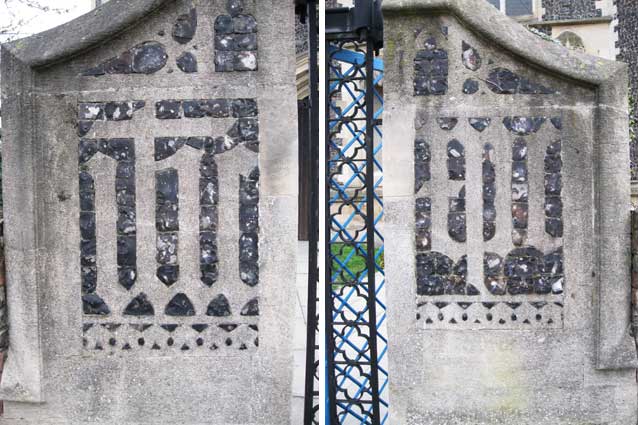
Ipswich's resident expert on all things architecturally ecclesiastical,
Simon Knott opines:
1. "These are both examples of the so-called 'sacred monogram', the
letters 'IHC', the first three letters of the Greek word
for Jesus
IHCOYC. The bar across the top shows that it is an abbreviation (and,
incidentally, forms a cross). It is more usually found in its Latin
form IHS, although the Greek form was popular among 19th century church
restorers because Greek was considered less 'popish' than Latin.
The monograms may date from George Gilbert Scott's restoration of 1878
- but in fact I think that they are probably later, perhaps 1890s.
Having them on the gates would have been considered quite demonstrative
in the 1870s."
2. "...I recall that it is a monogram of SP for Sanctus Petrus, the
Holy Rock, that is to say Saint Peter, a 19th century restoration of
what may, or may not, have been there before..."
Thanks to Simon.
Inside the church: Ledger slabs
This website doesn't usually tiptoe into the realm of the inscriptions
within churches, but a meeting with Roger and Stella Wolfe, long-time
members of The Ipswich Society, drew our attention to the importance of
the collection of large floor stone memorials within St Peter. We are
most grateful to Roger and Roy Tricker for unearthing the
transcriptions and are pleased to include a PDF of The Ledger
slabs of St Peter document and these two photographs to give a
flavour of the carved lettering.
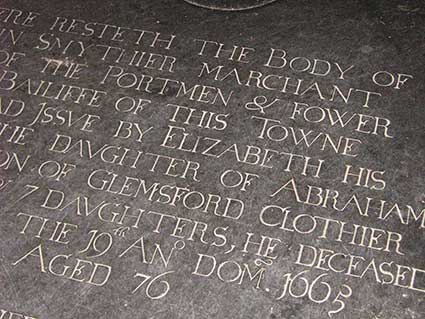 Photographs
courtesy Roger Wolfe
Photographs
courtesy Roger Wolfe

[UPDATE 24.6.2021: Jill
Freestone informs us that the ledger stone leaflet is still in print
and available to visitors to the church so, pandemic permitting, the
public should be able to pick up a copy.]
[UPDATE: 25.6.2021: 'Lovely to
get your email and your informative page. When researching the church
guide, I scoured newspaper reports and parish documents to trace Scott
Jr's restoration, which took place in three phases. The first, in 1874,
was the rebuilding of the south porch. The second, in 1877, was far
more intense, and definitely involved the south gates and their
flanking flushwork 'P' panels. The report however stated that the
western gates and their surrounding flintwork, although planned, were
still to be erected. Maybe this was during the third phase, in 1879-80
or, as you suggest later, although I didn't trace any mention of them
in later developments at the church. I do agree that this workmanship
is rather adventurous, particularly in a church which had an
unashamedly Evangelical tradition! Roy Tricker.']
St Peter's Hall, which we assume is the
Victorian red brick hall related to the church, is sited in St Peter's
Street. And if you ever wondered where St
Peter's Vicarage was, until c.1925 it was to be found in Over
Stoke. Note also the Vernon Street
Mission Room which started life as an extension of St Peter.
For an aerial view of the area see our Trinity
House buoy page.
See our Links page for Simon's famous Suffolk
Churches website.
Home
Please email any comments and contributions by clicking here.
Search Ipswich
Historic Lettering
©2004 Copyright
throughout the Ipswich
Historic Lettering site: Borin Van Loon
No reproduction of text or images without express written permission
 2011 image
2011 image
 Flushwork
'P'
Flushwork
'P'  2013 images
2013 images

 Photographs
courtesy Roger Wolfe
Photographs
courtesy Roger Wolfe